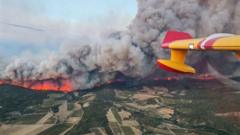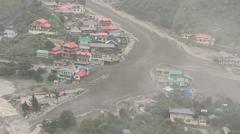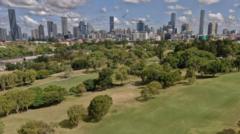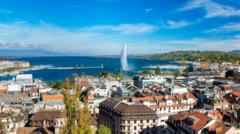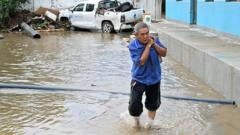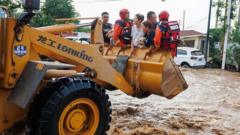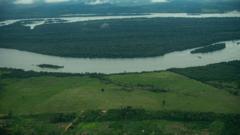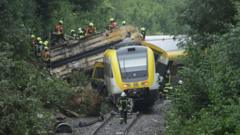In light of recent disasters, the viability of preserving alpine villages is under scrutiny as Switzerland confronts the ramifications of climate change.
**Alpine Villages at Risk: Are Costs to Save Them Justifiable?**
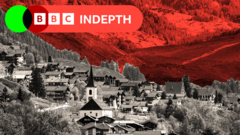
**Alpine Villages at Risk: Are Costs to Save Them Justifiable?**
As climate change induces glacier melt and landslides, Swiss communities face tough choices about their future.
A quaint village nestled in Switzerland's picturesque Loetschental valley is facing a stark new reality. Mayor Matthias Bellwald walks through his community while greeting familiar faces, yet the nearby village of Blatten has been completely erased from existence, swallowed by a catastrophic glacier-driven landslide just two months ago. The villagers, once proud residents of a community with a rich history, were evacuated days prior due to the imminent threat posed by the unstable mountain, leading them to lose their homes, businesses, and cherished landmarks.
This has been a personal tragedy for many, including third-generation hotelier Lukas Kalbermatten, who reminisces about his childhood memories now buried beneath thousands of cubic meters of ice, mud, and rock. "Everything is gone," he laments. Currently, he, along with many others from Blatten, is residing in temporary accommodations in the nearby village of Wiler. With heavy financial implications, rebuilding the village is estimated to cost upwards of hundreds of millions of dollars, potentially reaching $1 million per resident. While government assistance and public donations have amassed significant funds for recovery, there’s a growing debate around whether the investment is truly worth it.
Switzerland's mountainous terrain covers approximately two-thirds of the nation, and climate experts are alerting officials about the escalating dangers posed by warming temperatures on glacial and permafrost stability. "This is leading to an increased frequency and unpredictability of landslides," warns glaciologist Matthias Huss from Zurich's Federal Institute of Technology. The disasters aren't merely anomalies anymore; they reflect a troubling trend that could endanger more villages if precautionary measures and interventions aren't significantly bolstered.
Alpine traditions and cultural identities are intricately linked to these communities, sparking fears that if evacuations and relocations become common, the unique heritage could become extinct. An influential editorial in the Neue Zürcher Zeitung recently suggested that reliance on urban tax revenue to prop up these at-risk villages is becoming untenable with the reality posed by climate change.
The Swiss landscape, much adored for its breathtaking views and stability, may be facing radical transformations if conditions do not improve. As residents of other villages, such as Brienz in the Graubünden region, face uncertainty regarding their return due to unstable land, a larger conversation is emerging around the future of these alpine regions.
Authorities like Boris Previsic from the University of Lucerne's Institute for the Culture of the Alps advocate for adaptive strategies. "We must be flexible and consider possible evacuations," he expresses, recognizing that nature’s forces are beyond human control. Amid burgeoning concerns, locals are determined to cling to their heritage, placing high value on their 'heimat'—their sense of home rooted in the valley's rich traditions.
As economic burdens collide with cultural sentiments in the wake of systematic disasters, Switzerland stands at a crossroads. With recovery efforts underway in Blatten highlighted by a visible military presence and intricate logistics, its residents maintain hope. “We must persevere,” reflects Kalbermatten, echoing a resilient spirit among the members of a community still striving to reclaim their lost history.
This has been a personal tragedy for many, including third-generation hotelier Lukas Kalbermatten, who reminisces about his childhood memories now buried beneath thousands of cubic meters of ice, mud, and rock. "Everything is gone," he laments. Currently, he, along with many others from Blatten, is residing in temporary accommodations in the nearby village of Wiler. With heavy financial implications, rebuilding the village is estimated to cost upwards of hundreds of millions of dollars, potentially reaching $1 million per resident. While government assistance and public donations have amassed significant funds for recovery, there’s a growing debate around whether the investment is truly worth it.
Switzerland's mountainous terrain covers approximately two-thirds of the nation, and climate experts are alerting officials about the escalating dangers posed by warming temperatures on glacial and permafrost stability. "This is leading to an increased frequency and unpredictability of landslides," warns glaciologist Matthias Huss from Zurich's Federal Institute of Technology. The disasters aren't merely anomalies anymore; they reflect a troubling trend that could endanger more villages if precautionary measures and interventions aren't significantly bolstered.
Alpine traditions and cultural identities are intricately linked to these communities, sparking fears that if evacuations and relocations become common, the unique heritage could become extinct. An influential editorial in the Neue Zürcher Zeitung recently suggested that reliance on urban tax revenue to prop up these at-risk villages is becoming untenable with the reality posed by climate change.
The Swiss landscape, much adored for its breathtaking views and stability, may be facing radical transformations if conditions do not improve. As residents of other villages, such as Brienz in the Graubünden region, face uncertainty regarding their return due to unstable land, a larger conversation is emerging around the future of these alpine regions.
Authorities like Boris Previsic from the University of Lucerne's Institute for the Culture of the Alps advocate for adaptive strategies. "We must be flexible and consider possible evacuations," he expresses, recognizing that nature’s forces are beyond human control. Amid burgeoning concerns, locals are determined to cling to their heritage, placing high value on their 'heimat'—their sense of home rooted in the valley's rich traditions.
As economic burdens collide with cultural sentiments in the wake of systematic disasters, Switzerland stands at a crossroads. With recovery efforts underway in Blatten highlighted by a visible military presence and intricate logistics, its residents maintain hope. “We must persevere,” reflects Kalbermatten, echoing a resilient spirit among the members of a community still striving to reclaim their lost history.


